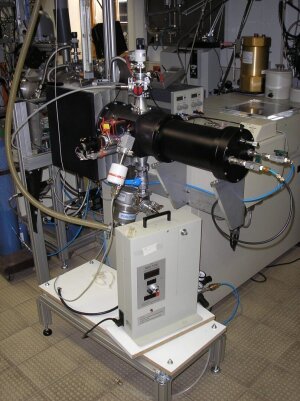Aerosol Infrared Spectroscopy
Photograph of the setup: Aerosol cell (black), Dust disperser (grey, below), IR spectrometer (grey, behind)
Foto: AIUHere, we measure the infrared absorption spectra of dust particles, which are dispersed in N2 gas. This technique avoids the embedding in a solid or liquid environment, which is normally used for spectroscopic measurements. This embedding is known to produce a change of the absorption band profiles by the electromagnetic influence of the solid or liquid matrix.
The aerosol is produced by a commercial disperser (Palas RBG 1000) and is filling a gas cell (White-type multi-reflection IR cell) through which the IR beam of the spectrometer propagates. Dust particles smaller than about 1 micrometer in size sediment slowly enough to allow measurements of the absorption spectrum (non-quantitative because the dust column density is unknown). Larger grains can also be measured when sedimentation is balanced by continuous aerosol supply. However, in this case scattering of the IR radiation becomes also important and will influence the spectra limiting their applicability.
A great advantage of the aerosol method is that the aerosol particles can be collected on a filter after measurement, so that their morphology (e.g. the state of agglomeration) can be directly observed, e.g. by electron microscopy. The measured infrared spectra and corresponding images of the particles are made public by an internet database.
This work has been supported by DFG grants MU 1164/5 and MU 1164/6 (partly within the Forschergruppe 388).
